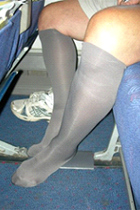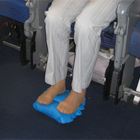Holidays often mean a fair amount of travelling and when you are sitting still for long periods of time, the risk of developing deep vein thrombosis (DVT), a blood clot that forms in the deep vein of the leg, becomes higher.
Clots can develop for a number of reasons, but when blood passes more slowly through the veins, which is what can happen on a flight (or sitting long periods in the car, at an office desk or even in front of TV) it can make it more likely. But there are ways you can reduce your risk when taking to the skies.
 Compression socks are recommended for long-haul travel. They have been shown to reduce the risk of a blood clot by up to 90%. Ask your GP or healthcare team if flight socks are suitable for you. They are not suitable for everyone. They give support to your legs, but must be worn correctly – if not, they can restrict blood flow and lead to more problems. One specialist advises being fitted for below knee, grade 1 compression socks which are available in selected pharmacies but there are a variety of types on the market.
Compression socks are recommended for long-haul travel. They have been shown to reduce the risk of a blood clot by up to 90%. Ask your GP or healthcare team if flight socks are suitable for you. They are not suitable for everyone. They give support to your legs, but must be worn correctly – if not, they can restrict blood flow and lead to more problems. One specialist advises being fitted for below knee, grade 1 compression socks which are available in selected pharmacies but there are a variety of types on the market.
An article in “Diabetes News”, (Issue 4, 2009) warns, “People with peripheral vascular disease or poor lower leg circulation should be cautious with compression socks, which may overly reduce blood circulation to their legs.”
During the flight, don’t cross your legs and don’t stay seated the whole time. Make sure you get up and walk around regularly. While sitting, tense and relax the muscles in your legs at regular intervals and move your feet around. Drink plenty of water to avoid dehydration. This will help to keep your circulation healthy.
Symptoms of DVT in leg veins include: feeling pain, tightness, swelling, tenderness and discolouration – often a dusky blue-red. Symptoms usually develop after the flight and you need to get medical advice straight away. But if you have signs of DVT while on the plane, explain your symptoms to a flight attendant, who can help you until you can be properly treated.
If you find your feet swell, you suffer cramps, aches and pains or stiffness while sitting, the Aircycle circulation booster can be an additional aid to comfort. It helps to reduce foot and ankle swelling so that your feet fit comfortably back into your shoes when you disembark. By adjusting the air as necessary, it can also be used as a back or neck rest.
 But most importantly, if used correctly throughout the flight, the Aircycle provides an easy way to boost circulation in the feet and legs and help avoid the chance of a blood clot forming. The “treadle” exercise works the calf muscles, which pump and encourage blood flow in the feet and legs. It is this exercise which is most valuable while travelling – especially for older people and those on certain medications who are at greater risk during long periods of immobility. Keep the Aircycle at your feet throughout the trip and use it frequently, with slow, even movements.
But most importantly, if used correctly throughout the flight, the Aircycle provides an easy way to boost circulation in the feet and legs and help avoid the chance of a blood clot forming. The “treadle” exercise works the calf muscles, which pump and encourage blood flow in the feet and legs. It is this exercise which is most valuable while travelling – especially for older people and those on certain medications who are at greater risk during long periods of immobility. Keep the Aircycle at your feet throughout the trip and use it frequently, with slow, even movements.
While resting or sleeping, the Aircycle may be placed under your thighs, just above the knees, to relieve the pressure where the edge of the seat sometimes cuts off your circulation. It is thought that during sleep we are at greater risk of clots occurring.
To ensure you travel comfortably, relax and enjoy your flight, be well prepared before you set out. Discuss any particular health issues you may have with your doctor and follow his advice. He is the one who knows you best and can give you the best advice.
The Aircycle fits neatly in a pocket or purse when travelling. It is registered with Medsafe and carries a lifetime guarantee.









Join the Discussion
Type out your comment here:
You must be logged in to post a comment.